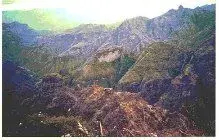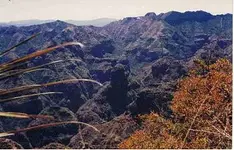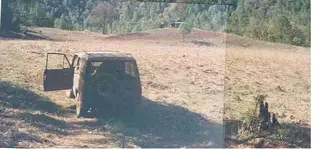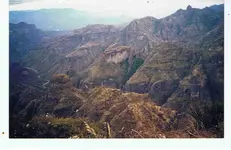I believe that there were 3 groups or the priests. Those that operated the "Mule Trail Hiway", those that were in charge of the mining operations, and overseeing the raising of crops for the miners, and those at the "Home Mission" outside of Mexico City. The overseers of the other 2 types/groups. Now the first group, only knew about taking care of the mules between shipments, no knowledge of where the mines actually were located.
The second group hid the gold and silver bullion when warning arrived from the first group. They also hid any evidence of the mines. They were the ones that knew where the "bodies" lay, and they didn't survive the trip home and the questions asked by the Spanish questioners. The third group doesn't have any idea where the actual mines and missions were that were shipping the bullion home. They would have been more like accountants (Bean Counters) .
This is just what I believe using "Human Nature" as a guide. If you think of it as a large Corporation. The "Bean Counters" have no idea of the actual requirements of keeping the customers happy, just the "Bottom Line".
Just for the sake of argument, let's assume the various rumors of rich Jesuit mines and vast precious metals hoards in Arizona are true. This is a stretch for me, since I don't support these types of treasure magazine stories - but let's look at the situation for a moment as if they are true.
The alleged mines and caches are considered "lost" because when the expulsion came down, the brothers who were in the know left the scene and were unable to retain the knowledge of where all the loot was located. The mines/caches were masterfully hidden prior to abandonment, but the details of "where they were" evaporated due to any number of explanations, leaving numerous mondo-rich mines and perhaps tons of bullion caches (most logically in the mines) covered up ... somewhere. Audigger53, you offer support to this scenario based on a "bottoms up" chain of command for the alleged mines. I have to strongly disagree, and, based on the Jesuits' reputations, have to assume that any situation involving rich illegal gold mines was run from the "top down" - the top being all the way back home in Europe.
1.
If these rumors of "fabulously rich illegal mines" were true, then the most important details of the operations would have obviously been the
locations of the mines. The Jesuits, being the so-called "smartest guys in the room", the "navy seals of their day", etc., would immediately have recognized the importance of their newly discovered mines and, being world-class military strategists and logistics experts, would certainly have planned for all contingencies and quickly documented the coordinates of the mines and sent the information back home. They would have secured this information "just in case" the illegality of their actions came back to haunt them later and they needed to hide their "secret illegal mines." That's what smart guys do when they're acting illegally. [I still find it hard to believe they could have operated rich gold mines under the noses of the Spanish for years, but that's another problem we'll ignore here]
2. How could the Jesuits accurately record the mines' locations? This was the Age of Enlightenment after all, and the Jesuits arguably had access to the best educations and the best cutting-edge technologies of the day - not to mention the possibility of proprietary ancient records secreted in the Vatican's libraries. Anyone who is aware of the 16th century accomplishments in Europe, the education available to the elite, and the enlightened technology in use at the time (a stroll through the Galileo Museum in Florence will soon convince you of this) will realize that sophisticated science may well have been transferable even to the uncharted frontiers of the New World - at least as far as celestial navigation is concerned.
How could highly accurate lat/long coordinates be obtained? The Romans were able to determine latitude (north or south angular deviation from the equator) to about 1/4 degree, ~20 miles+/-. On dry land with the very best instruments and trained observers from the Renaissance era, results matching the accuracy limits of the human eye of about one minute of arc were theoretically possible and probably attainable, ~1 mile+/-. Pretty good. But what about longitude?
The determination of longitude is all about time - east/west angular (degrees, aka hours, minutes and seconds) deviation from an arbitrary base point on the globe (Greenwich Observatory in England nowadays, but many other places before). Here's where the resources available to the Jesuits and other elites through history affect this argument. I won't get lengthy here (I can though), but it seems quite likely that the Vatican and other elites had access to technology and data originating from the Giza pyramid that allowed accurate determination of longitude based on observations of celestial objects in the earth's ecliptic - not polar - plane. Accuracy of ~1 mile+/- would theoretically be obtainable with proper instruments. This too is good - allowing for lat/long coordinates both falling within a one-mile radius circle on land.
3.
How could the Jesuits securely report the mines' locations to their superiors? This is probably the easiest part. Whoever calculated the mines' coordinates - early in the mines' histories of course - could have either carried the information home with him, or sent it in a coded form. Any number of code techniques could have been used to provide secret information within normal-appearing boring reports, letters, etc. Duck soup for the smartest guys in the world, right? Then it's business as usual. Work the mines, cache the bullion, ship it home now and then, and if the SHTF, cover up the mines and leave them behind to hopefully reopen later. Makes more sense than getting caught with your pants down and losing the locations of these rich mines and fabulous hoards due to being stupid and unprepared.
Of course, my speculation counters the "Jesuits lost their own mines" silliness, but it doesn't answer the big question -
why are the mines/caches still lost? Well, there are two more thoughts to consider. First, why haven't the Jesuits reclaimed these fabulous mines and caches? Surely, the smartest guys in the world didn't "lose" them. If they were "illegal gains" to start with, fine - set up dummy corporations of "innocents" to find and exploit them for you. After all, money is money, and the Catholic Orders live on money too, don't they? Or ... thought two: the fabulous mines/caches live in treasure magazines only and there is nothing worthy of recovering in reality. As I've argued before, the Jesuits likely did modest silver mining in Arizona in order to be able to create some church bling and have a little pocket money for trade items, but the well-known legends are completely overblown and essentially baseless. Or, to prop up the legends, I guess we can just assume the Jesuits were dummies.



 They soon became the largest slave-owners in Maryland in fact. The Jesuits in French Louisiana province were also found to be owning a large number of slaves when they were expelled by the French in 1764. Yet today we have had Jesuits claiming they never owned any slaves! '
They soon became the largest slave-owners in Maryland in fact. The Jesuits in French Louisiana province were also found to be owning a large number of slaves when they were expelled by the French in 1764. Yet today we have had Jesuits claiming they never owned any slaves! '







